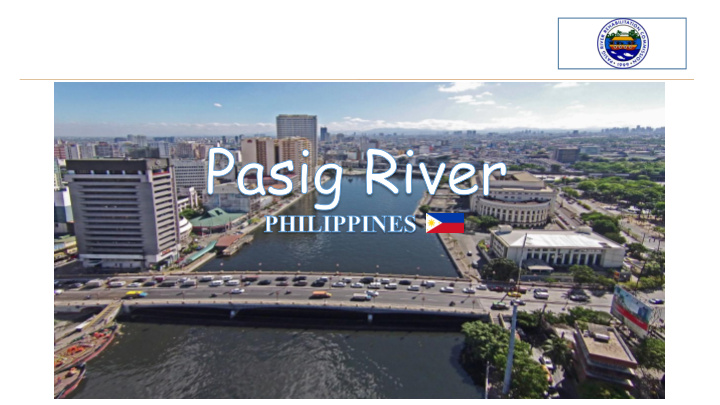



MANAGED BY
The Pasig River when it was declared “biologically dead” in the 1990’s. 1930’s: Decrease in fish migration 1950’s: Noticeable decline in the people’s bathing activities 1960’s: Obvious drop in both bathing and washing activities 1970’s: The river began to smell bad and water quality fell Class “C” level below 1980’s: All fishing activities stopped 1990’s: The Pasig River was declared biologically dead 30.00 mtpd 75.00 135.00 Maximum assimilative capacity of Pasig River is at 200+/day of BOD Loading mtpd mtpd 135.00 1990 = 48% Higher 2000 = 20% mtpd ( ≥ 300 MTPD) ( ≥ 240 MTPD)
“Biodiversity Assessment of Pasig Trees and Other Vegetation • 118 species under 94 genera and 42 families; and River and Its Tributaries: Ecosystems • Mango, Banana and Ipil-Ipil as the most dominant Thirty Nine (39) Species of Birds Approach (Phase One)” • 54 % are resident species; By: Carmelita Villamor, et.,al. • 31 % are migratory; and Department of Environment and Natural Resources - Ecosystems • 15% are endemic Research and Development Bureau (DENR-ERDB) September 2008 to February 2009 Eight (8) Fish Species • Kanduli or Manila sea catfish Objective(s): • Mamaling or Bighead carp • Determine the Biodiversity Status of the Buan buan (Indo-Pacific tarpon) • Dalag (Snakehead murrel) River • Gurami (Snakeskin gourami) Provide suitable indicators to determine the • Talilong (bluespot mullet) • Tilapia (Nile Tilapia) impacts of rehabilitation activities • Janitor fish or Sailfin catfish Aquatic plants Result(s): • Water hyacinth (Eichornia crassipes); Several species of fish, birds, trees and • Hornworth (Ceratophyllum demersum); and aquatic plants are now living in the river or • Kangkong (Ipomoea aquatic) and Quiapo (pistia stratoites) within its left and right embankment
WHAT ARE WE DOING TO SAVE THE PASIG RIVER?
CONVERGENCE is key to success
PRRC is composed of representatives from various agencies in the national government, local government, non- government, and private agencies organized into Technical Working Committees in order to fully address the different sectoral concerns of rehabilitating the Pasig River.
EASEMENT RECOVERY, HOUSING AND RESETTLEMENT
We relocate people not to deprive them of their basic right to live BUT TO SAVE THEM FROM DANGER and PROVIDE THEM A BETTER LIFE and OPPORTUNITIES .
RIVERBANKS DEVELOPMENT AND FLOOD CONTROL
There is HOPE
ENVIRONMENTAL MANAGEMENT Through waste management and water quality improvement technologies
MULTILEVEL PUBLIC AWARENESS
OPPORTUNITIES have opened
Perceived Benefits of Residents of Paco Agree Disagree Quality of life has Feel Less Sick 89% 11% Lower Medical Expenses 85% 15% IMPROVED Community Pride 97% 3% Happier Community 97% 3% Stronger Unity 96% 4% 85% said their families saved P819 Feel Safer 89% 11% a month on health. Motivation to Clean Up 97% 3% 40% reduction in crime. Greater Peace of Mind 97% 3% Getting More Exercise 100% 0% Greater Life Satisfaction 97% 3%
THANK YOU VERY MUCH!
Recommend
More recommend